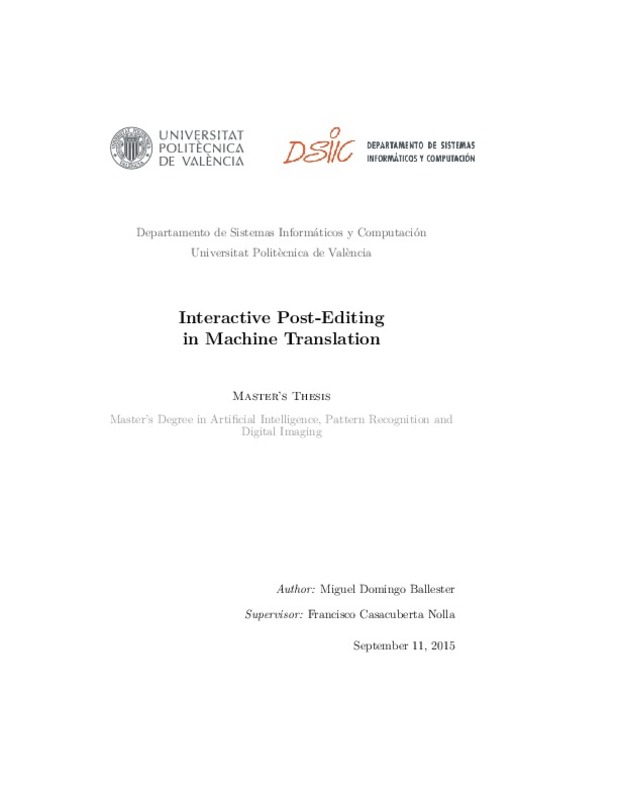JavaScript is disabled for your browser. Some features of this site may not work without it.
Buscar en RiuNet
Listar
Mi cuenta
Estadísticas
Ayuda RiuNet
Admin. UPV
Interactive post-editing in machine translation
Mostrar el registro sencillo del ítem
Ficheros en el ítem
| dc.contributor.advisor | Casacuberta Nolla, Francisco
|
es_ES |
| dc.contributor.author | Domingo Ballester, Miguel
|
es_ES |
| dc.date.accessioned | 2016-05-17T11:45:17Z | |
| dc.date.available | 2016-05-17T11:45:17Z | |
| dc.date.created | 2015-09-25 | |
| dc.date.issued | 2016-05-17 | |
| dc.identifier.uri | http://hdl.handle.net/10251/64251 | |
| dc.description.abstract | [EN] The current state of the art in Machine Translation (MT) is far from being good enough, with a post-process carried out by a human agent being necessary in many cases in order to correct translations. Statistical post-editing of a MT system has been used in the past to improve the translation quality of that system. Additionally, research on interactive translation prediction has been done with the aim of reducing the human post-editing effort. In this thesis, a new methodology that combines both techniques is proposed in order to, given a MT system, increase the translation quality of that system and reduce the effort that the human agent needs to make in order to correct the translation of that system. This methodology is tested on different scenarios (to connect with the output of a rulebased machine translation system, and as a method to adapt an statistical MT system from one domain to another) with different corpora, obtaining very encouraging results | es_ES |
| dc.description.abstract | [ES] El estado actual del arte en traducción automática (Machine Translation, MT) todavía no es lo suficientemente bueno, siendo en muchos casos necesario un post-proceso llevado a cabo por un agente humano a fin de corregir las traducciones. La post-edición estadística de un sistema de MT se ha utilizado en el pasado para mejorar la calidad de traducción de dicho sistema. Además, se han llevado a cabo investigaciones en traducción mediante predicción interactiva con el objetivo de reducir el esfuerzo humano de post-edición. En esta tesis se propone una nueva metodología que combina ambas técnicas a fin de, dado un sistema de MT, incrementar la calidad de traducción de dicho sistema y reducir el esfuerzo que el agente humano ha de hacer a la hora de corregir las traducciones de dicho sistema. Esta metodología ha sido probada en diferentes escenarios (para conectar la salida de un sistema de traducción basado en reglas, y como método para adaptar un sistema de MT estadístico de un dominio a otro) con diferentes córpora, obteniendo resultados muy esperanzadores. | es_ES |
| dc.format.extent | 56 | es_ES |
| dc.language | Inglés | es_ES |
| dc.publisher | Universitat Politècnica de València | es_ES |
| dc.rights | Reconocimiento - No comercial - Sin obra derivada (by-nc-nd) | es_ES |
| dc.subject | Traducción automática estadística | es_ES |
| dc.subject | Post-edición estadística | es_ES |
| dc.subject | Traducción automática basada en reglas | es_ES |
| dc.subject | Adaptación al dominio | es_ES |
| dc.subject | Traducción mediante predicción interactiva | es_ES |
| dc.subject | Statistical machine translation | es_ES |
| dc.subject | Statistical post-editing | es_ES |
| dc.subject | Rule-based machine translation | es_ES |
| dc.subject | Domain adaptation | es_ES |
| dc.subject | Interactive translation prediction | es_ES |
| dc.subject.classification | LENGUAJES Y SISTEMAS INFORMATICOS | es_ES |
| dc.subject.other | Máster Universitario en Inteligencia Artificial, Reconocimiento de Formas e Imagen Digital-Màster Universitari en Intel·ligència Artificial, Reconeixement de Formes i Imatge Digital | es_ES |
| dc.title | Interactive post-editing in machine translation | es_ES |
| dc.type | Tesis de máster | es_ES |
| dc.rights.accessRights | Abierto | es_ES |
| dc.contributor.affiliation | Universitat Politècnica de València. Servicio de Alumnado - Servei d'Alumnat | es_ES |
| dc.description.bibliographicCitation | Domingo Ballester, M. (2015). Interactive post-editing in machine translation. Universitat Politècnica de València. http://hdl.handle.net/10251/64251 | es_ES |
| dc.description.accrualMethod | Archivo delegado | es_ES |






